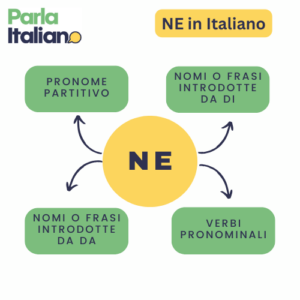Italian reflexive verbs are a challenging grammar item to learn for native English speakers. This is rather surprising considering that the concept of a reflexive verb exists in English and the Italian conjugation is fairly simple.
However, there are a few differences between the languages that create some problems.
In this article you can expect to learn:
- What is a reflexive verb
- How to conjugate reflexive verbs in Italian
- What are the reflexive pronouns
- How to recognise a reflexive verb
- What is the difference between riflessivi propri, apparenti and pronominali
- Why they are difficult for English speakers
- What to do to solve the problem and learn them easily
- The most common Italian reflexive verbs
- A list of ten for the more advanced students
- How to conjugate these verbs in the past tense
.
What are reflexive verbs?
Simply put, this verb is an action done to oneself, for example: I wash myself. He introduces himself. You teach yourself Spanish. They shave themselves.
Grammatically, it is a verb which subject and object are the same, in other words the action expressed by the verb is performed and received by the same subject. Let’s see this with the previous example:
I wash myself. I is the subject, wash is the verb, myself is the object. As you can see the subject and the object are the same. In other words, I perform the action of washing and the object of the action is I (myself).
.
How to conjugate reflexive verbs in Italian
The conjugation of reflexive verbs in Italian is relatively easy to learn especially if you have already mastered the regular verbs in the present tense. A reflexive verb is a ‘normal’ verb with the addition of the reflexive pronoun.
Here is an example of a regular verb and its reflexive version:
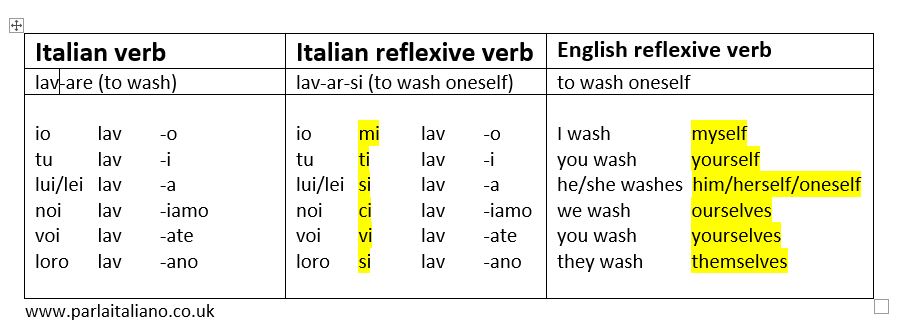
As you can see, the Italian reflexive verb is conjugated exactly as in the non-reflexive version and the reflexive pronoun is added between the subject and the verb: Io (subject) mi (pronoun) lavo (verb).
Here are a couple of sentences using a non-reflexive and a reflexive verb:
(Io) lavo la macchina (non-reflexive)
(Io) mi lavo (reflexive)
What are the reflexive pronouns?
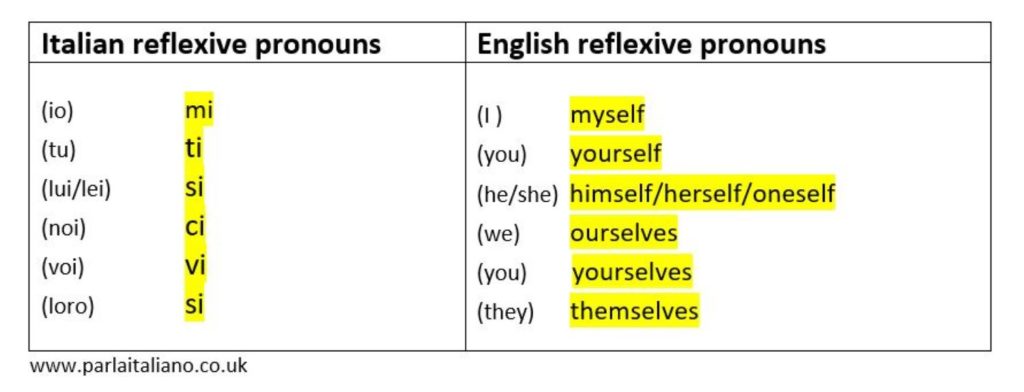
In English, the pronouns myself, yourself, herself, etc, are called reflexive pronouns. In Italian the reflexive pronouns are 5 and are the same for all three conjugations (-are, -ere, -ire), see table above and are always used together with the reflexive verb, unlike in English. More on this later.
How to recognise a reflexive verb:
It is easy to recognise a reflexive verb as it always ends in -arsi/-ersi/-irsi in the infinitive. The infinitive is the version of the verb that you will find in the dictionary. It is also easy to identify to which conjugation (-are, -ere or -ire) it belongs to.
Look for example at these verbs: alzarsi, muoversi, vestirsi.
Alzarsi is the reflexive version of the regular verb: ALZ-ARE. In the reflexive version the ending -e is dropped and -si added: ALZ-AR-SI.
The same is true for the other two verbs: muov-er-si comes from muov -ere and vest-ir-si comes from vest -ire.
Reflexive regular verbs: the 3 conjugations
Here is a table to show you how to conjugate reflexively the 3 main regular verb groups in the present tense (presente indicativo):
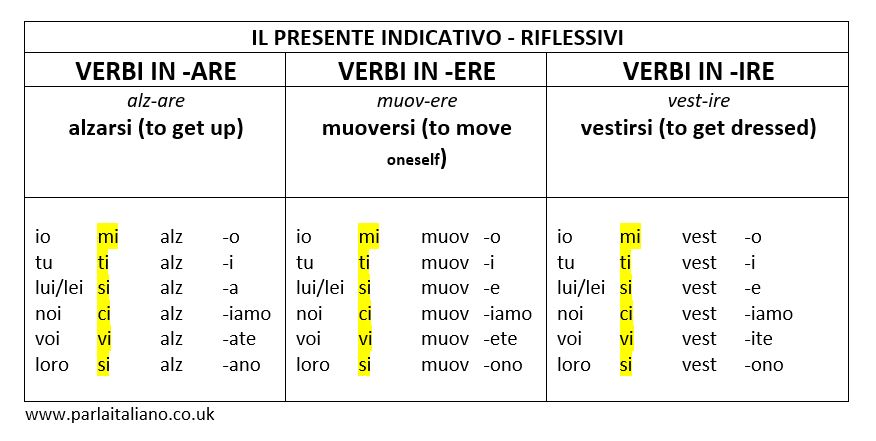
.
Why are reflexive verbs difficult for English speakers?
There are three main reasons for the confusion:
- it is tricky to identify which verb is reflexive in English
- even if you can identify them, the reflexive verbs in English not always correspond to reflexive verbs in Italian
- many verbs in Italian conjugate as reflexive but their meaning is not reflexive
1. It is tricky to identify which verb is reflexive in English
The first difference is that in English, the reflexive pronoun is not always included, especially if the pronoun is obvious. For example, English speakers say:
Lynn gets dressed – rather than – Lynn gets herself dressed = Lynn si veste
or
I get up – rather than – I get myself up = Io mi alzo
To complicate things, sometimes, the reflexive pronouns myself, yourself, etc, are used in a non-reflexive way in English. For example “she applied herself to the work”. In this case it means that she gave her full attention to the work. Therefore, this is not a reflexive verb.
This makes it tricky to identify which verb is reflexive in English.
2. Some reflexive verbs in English do not correspond to reflexive verbs in Italian
Here is an example. In English you can say: I drove myself to the party but you cannot translate that literally in Italian. Guidare is not a reflexive verb and you wouldn’t use it in this case either. So you would say: Sono andata alla festa con la mia macchina.
3. Many verbs in Italian conjugate as reflexive but their meaning is not reflexive
In Italian there are various categories of verbs that conjugate like reflexive verbs but do not have the reflexive meaning as seen above. This is probably the main cause of the confusion.
In fact, we have three categories of verbs that look reflexive but are not. These are:
- riflessivi apparenti
- riflessivi reciproci
- riflessivi pronominali
Riflessivi apparenti
With these verbs the action is not done onto oneself but onto something else.
For example: tagliarsi le unghie, pettinarsi i capelli, prepararsi la cena
So, what is the difference between a reflexive and a false reflexive (riflessivo apparente)?
The first is for example: mi taglio (I cut myself), but mi taglio le unghie is not reflexive (I cut my fingernails, not myself)
Other examples are: mi pettino i capelli, mi preparo la cena, etc.
Riflessivi reciproci
These verbs describe a mutual (reciprocal) action, done by two people to each other as in guardarsi (to look at each other), abbracciarsi (to hug each other), picchiarsi (to hit each other), etc.
For example: Carlo e Antonella si guardano. Leo e Marco si abbracciano. Luca e Carletto si picchiano.
Riflessivi pronominali
This last category includes verbs such as: chiamarsi, svegliarsi, accorgersi, etc.
These verbs are called pronominali as the reflexive pronouns does not have a reflexive meaning but gives the verb a different meaning then its version without the pronoun.
Let’s see an example:
Mi chiamo means my name is, it does not mean I call myself. Everyone calls me Laura, I am not called Laura only by myself.
As you can see, this verb has a specific meaning which is different than the meaning of chiamare.
A true reflexive verb maintains its meaning from the non-reflexive to its reflexive form,
for example:
Lavare (to wash) has the same meaning as lavarsi (to wash) only in the second case the action is done onto oneself.
Another way to recognise these, is that they are intransitive, which means that they cannot have an object.
No need to worry too much about intricacies
Do not worry about understanding completely the finer point of these different groups. Especially if you have not yet achieved the B2 level. So long as you understand that the reflexive form does not always indicate something done onto oneself, that would be enough to start with.
What to do to solve the problem
First of all, becoming aware of the why these verbs are difficult is a good start. This is explained above.
The second thing I recommend is to keep a notebook and ‘collect’ your reflexive verbs as you learn them.
*Please note that I will use – from now on – the word reflexive in a very general term, as in all verbs that are conjugated in the reflexive form.
So, why not just copy and paste a full 5-page list of verbs? I can hear you ask. This is because each verb needs to have been processed properly before you can add it to your list. I too have studied lists before, but those items remained on the paper, unused and eventually abandoned.
If you are a beginner, start with the usual verbs of routine (see below) and start incorporating them into your writing. Some examples of activities are:
- Write about your own routine
- Research verbs that are specific to your own routine, use the dictionary and internet.
- Write about someone else’s routine
- Compare the two
- Use this quizlet activity to practise the meaning of the verbs
- Use this quizlet activity to practise the conjugation of the present tense
Here is a starter list:
Starter list: 10 most common reflexive* verbs
| 1. | Chiamarsi | = To be called |
| 2. | Alzarsi | = to get up |
| 3. | Lavarsi | = to wash oneself |
| 4. | Pettinarsi | = to combe one’s hair |
| 5. | Radersi | = to shave |
| 6. | Rilassarsi | = to relax |
| 7. | Sedersi | = to sit down |
| 8. | Spogliarsi | = to undress |
| 9. | Svegliarsi | = to wake up |
| 10. | Vestirsi | = to get dressed |
www.parlaitaliano.co.uk
*I use the term reflexive in a very general way, including all verbs that are conjugated in the reflexive form.
The most common Italian reflexive verbs and some of the more advanced.
If, however, you are not a beginner, then you are ready for more advanced verbs. Here is the 20 essential reflexive verbs that you must learn at intermediate level. As said previously, start by choosing some that you want to explore and use actively in your writing (and speaking, for example, if you attend a class).
20 Italian essential reflexive* verbs
| 1. | abbronzarsi | = to get a tan |
| 2. | accorgersi | = to notice something |
| 3. | addormentarsi | = to fall asleep |
| 4. | annoiarsi | = to get bored |
| 5. | arrabbiarsi | = to combe one’s hair |
| 6. | decidersi | = to take a decision |
| 7. | divertirsi | = to have fun |
| 8. | inginocchiarsi | = to kneel |
| 9. | innamorarsi | = to fall in love |
| 10. | lamentarsi | = to complain |
| 11. | laurearsi | = to graduate |
| 12. | nascondersi | = to hide |
| 13. | pentirsi | = to regret |
| 14. | preoccuparsi | = to worry |
| 15. | ribellarsi | = to rebel |
| 16. | sentirsi | = to feel |
| 17. | sposarsi | = to get married |
| 18. | stancarsi | = to get tired |
| 19. | trasferirsi | = to move (relocate) |
| 20. | vergognarsi | = to feel ashamed |
www.parlaitaliano.co.uk
*I use the term reflexive in a very general way, including all verbs that are conjugated in the reflexive form.
A list of 10 for the more advanced students
| 1. | Abbuffarsi | = overeat, gorge on |
| 2. | Accaldarsi | = to get hot, overheath |
| 3. | Accigliarsi | = to frown, to scowl |
| 4. | Barcamenarsi | = barely managing to do something |
| 5. | Destreggiarsi | = to navigate a difficulty, manoeuver, find a way around |
| 6. | Dilungarsi | = to dwell, linger |
| 7. | Imbattersi | = encounter, come across smone or sthng |
| 8. | Lagnarsi | = to whine |
| 9. | Sbronzarsi | = to get hammered, drunk |
| 10. | Sgolarsi | = to shout to become hoarse |
www.parlaitaliano.co.uk
*I use the term reflexive in a very general way, including all verbs that are conjugated in the reflexive form.
How to conjugate these verbs in the past tense
For this part I will assume that you already know how to conjugate your regular verbs in the past tense passato prossimo and I will show you how to apply the rule to the reflexive verbs.
The good news is that there is no need to agonise over the choice between avere and essere. All reflexive verbs take essere as their auxiliary.
And again, all reflexive verbs are conjugated in the passato prossimo exactly as their non-reflexive correspondent.
See below a table with the three conjugations:
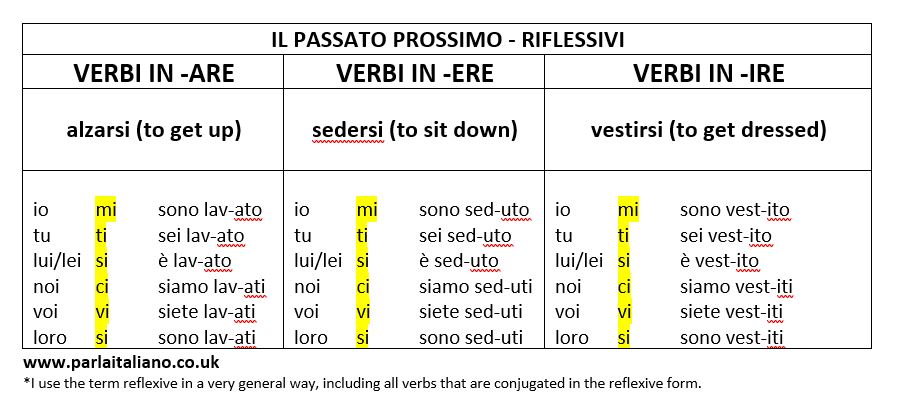
As you can see, the reflexive verbs follow the same rule as the other verbs and the only difference is the addition of the reflexive pronoun. As a reminder, the rule is:
- Conjugate the verb essere according to the pronoun.
Example Io mi sono lavato
- Then add the past participle following the usual rule:
Verbs in -are will change into -ato (for example: lav-are = lav-ato)
In -ere will change into -uto (for example: sed-ere = sed-uto)
And in -ire will change into -ito (for example: vest-ire = vest-ito)
- Remember to change the ending of the past participle according to the person, as you do for all verbs with essere:
Examples:
Laura si è sedut-a (a for feminine singular)
Luigi si è sedut-o (o for masculine singular)
Laura e Lisa si sono sedut-e (e for feminine plural)
Luigi e Aldo si sono seduti (i for masculine plural)
Conclusions
So to summarise, in Italian we have many verbs conjugated reflexively even if their meaning is not. Try not to translate literally and incorporate reflexive verbs slowly into your repertoire. Have a notebook where you ‘collect’ your new verbs. Make sure you have understood their meaning and note them down with examples. Last but not least, remember that for your everyday conversations you do not need a huge amount of new vocabulary, so take your time, move forward one step at a time and reflect on how far you have come!
In our classes, we specialize in simplifying complex topics to ensure they are easily absorbed. Ready to experience our classroom firsthand? Book a free trial lesson HERE and discover the joy of learning Italian.
Happy learning
Laura




